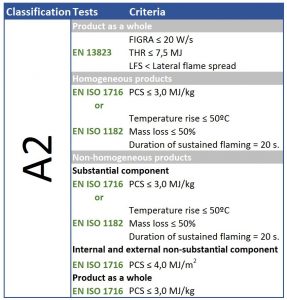
As you already know, the classifications A1 and A2 of the European classification system of reaction to fire are the highest and therefore, it is expected that products with this classifications offer a good performance in case of fire. Today, I present the necessary requirements to achieve these classifications, since I have sometimes encountered very curious situations when dealing with these classifications, such as once, in which a person told me that it is only necessary to test the product when it is intended to be A2 class because for A1 class it can be done directly because there is a list of A1 products without the need of testing. Therefore, today I will try to clarify the necessary tests and criteria as well as how to classify an A1 product without the need for testing.
The criteria for classifying a product as A1 or A2 are included in the EN 13501-1 standard. It is very important that you take into account that it is part 1, because the other parts of the same standard belong to fire resistance, roofs and cables.
In order to achieve a Euroclass A1, the following tests are required:

However, to get an A2, it is necessary to test the product in a compulsory way in the SBI test (EN 13823) and then you have to choose between the determination of calorific potential test (EN ISO 1716) or the non-combustibility test (EN ISO 1182).

Moreover, the classification criteria for the calorific potential test and the non-combustibility test are slightly more permissive for A2 than for a Euroclass A1. Something obvious.
On the other hand, most of the cases of heterogeneous products tested for a Euroclass A2, it is more appropriate to test the components of the product according to the calorific potential test.
Therefore, in order to get a Euroclass A1 or A2, specific tests have to be carried out and in the classification standard show the classification criteria that allow fire test laboratories to classify a product.
In addition, there is an option to classify products as A1 without the need for testing when they meet the conditions shown in Commission Decision 96/603/EC as amended by Decisions 2000/605 / EC and 2003/424 / EC. For a product to be considered A1 without the need for testing it must be manufactured from one or more of the materials that appear in that Decision, such as clay, perlite, vermiculite, etc. as long as the glue is present between the layers of the products do not exceed 0.1% by weight or volume and the organic content of the materials does not exceed 1.0%.
Bibliography
EN 13501-1. Fire classification of construction products and building elements – Part 1: Classification using data from reaction to fire tests
96/603/EC: Commission Decision of 4 October 1996 establishing the list of products belonging to Classes A ‘No contribution to fire’ provided for in Decision 94/611/EC implementing Article 20 of Council Directive 89/106/EEC on construction products (Text with EEA relevance)